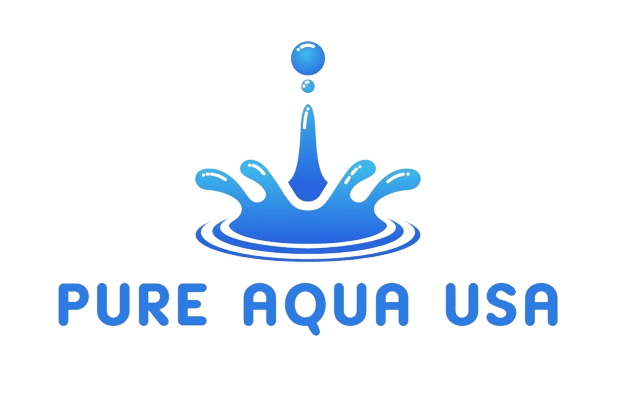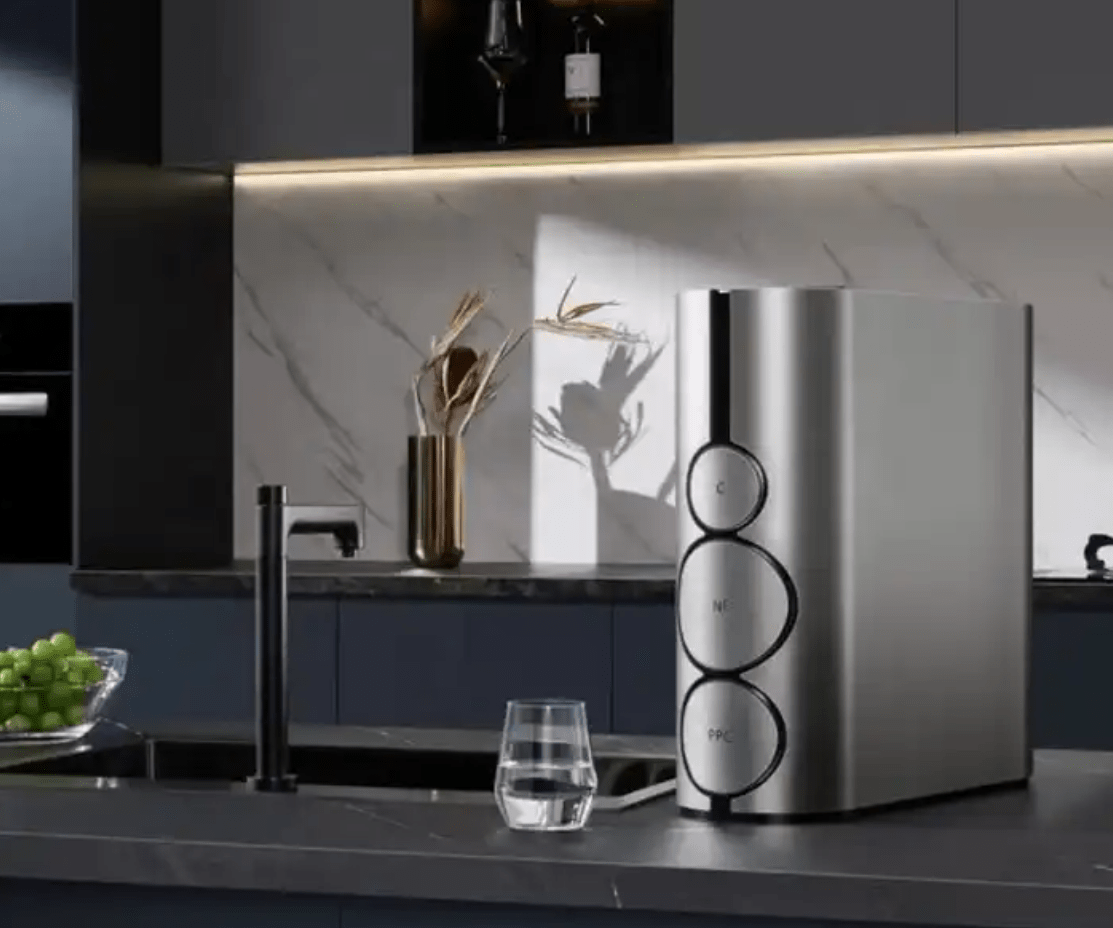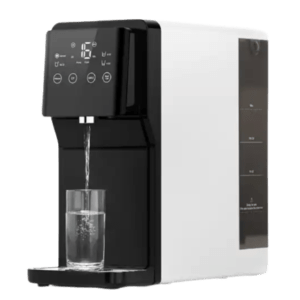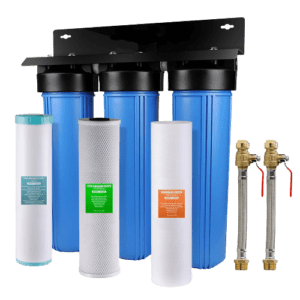Your cart is currently empty!
Reverse Osmosis Systems
A reverse osmosis system is a water purification technology that uses a semipermeable membrane to remove impurities and contaminants from drinking water. It effectively removes dissolved solids, chemicals, and other pollutants, resulting in clean, high-quality water. The system typically includes pre-filtration, membrane filtration, and post-filtration stages to ensure thorough purification. Reverse osmosis is widely used in residential, commercial, and industrial settings to provide safe and refreshing drinking water.
The reverse osmosis (RO) filter system uses five steps to process and clean water. First, it passes through a sediment pre-filter, to catch dust, dirt, and any other tiny particles in the water, including microscopic ones. The water then goes through a carbon pre-filter that removes unpleasant tastes and smells, like chlorine. The second carbon pre-filter serves the same purpose and refines the taste of the water even more. After the pre-filtering process, comes the reverse osmosis membrane. It screens out chemicals and dissolved solids like lead and copper. Finally, the polishing filter clarifies the water.
- Description
- Additional information
- Specifications
- Q&A
- Advantages and Disadvantages
- Applications
- Downloads
- Drawings
- Reviews (0)
Description
A reverse osmosis systems is a water purification technology that uses a semipermeable membrane to remove ions, molecules, and larger particles from drinking water. The process involves applying pressure to the water on one side of the membrane, forcing it to pass through while leaving contaminants behind. Reverse osmosis is commonly used to purify drinking water, desalinate seawater, and even treat wastewater. The system typically consists of several stages, including pre-filtration, membrane filtration, and post-filtration, each of which plays a crucial role in producing clean, high-quality water.
In a reverse osmosis systems, the pre-filtration stage is designed to remove larger particles, such as sediment, chlorine, and other impurities that could potentially clog or damage the membrane. This stage often includes a sediment filter, activated carbon filter, and sometimes a carbon block filter to ensure that the water entering the membrane is free from debris and contaminants.
The heart of the reverse osmosis systems is the semipermeable membrane, which acts as a barrier to allow water molecules to pass through while trapping dissolved solids, bacteria, and other harmful substances. The membrane’s small pore size ensures that only pure water can permeate, resulting in highly purified water on the other side.
After the membrane filtration stage, the water undergoes post-filtration to further enhance its quality. This stage may include another activated carbon filter to remove any remaining odors or tastes, as well as a polishing filter to ensure the water meets the desired purity standards.
Reverse osmosis systems are known for their ability to remove a wide range of contaminants, including heavy metals, dissolved solids, nitrates, and pesticides, making the water safe and pleasant to drink. Additionally, the process can effectively remove salts and minerals, making reverse osmosis ideal for desalination in areas where freshwater is scarce.
Overall, reverse osmosis systems are a highly effective and popular choice for residential, commercial, and industrial water purification needs. Their ability to produce clean, pure water by removing a wide array of impurities makes them an essential technology for ensuring access to safe and healthy drinking water.
One crucial aspect of reverse osmosis systems is their efficiency in removing various contaminants. The semipermeable membrane acts as a physical barrier, selectively allowing water molecules to pass through while blocking the majority of dissolved salts, minerals, and other impurities. This process leads to a significant reduction in total dissolved solids (TDS) in the water, resulting in a purer, clearer, and more refreshing taste compared to untreated water.
In addition to TDS, reverse osmosis systems are effective in removing pollutants such as lead, arsenic, fluoride, and various organic compounds that may be present in the water supply. The comprehensive filtration process helps ensure that the water produced by the system meets or exceeds regulatory standards for drinking water quality.
Another important consideration is the maintenance and upkeep of a reverse osmosis system. Regular maintenance, including replacing filters and inspecting the condition of the membrane, is essential to ensure consistent performance and water quality. Many systems are equipped with indicator lights or digital displays that signal when it’s time to change the filters, making it easier for users to stay on top of maintenance tasks.
Reverse osmosis systems come in various configurations to accommodate different usage scenarios. Residential systems are typically designed to fit under a kitchen sink and provide a dedicated supply of purified water for drinking and cooking. Meanwhile, commercial and industrial-scale systems can produce larger volumes of purified water to meet the demands of businesses, manufacturing facilities, and other applications.
It’s also worth noting that reverse osmosis technology has been instrumental in addressing water scarcity and brackish water treatment. By effectively removing salts and other contaminants from seawater and brackish sources, reverse osmosis has become a key method for producing freshwater in regions facing water shortages or limited access to clean water resources.
In summary, reverse osmosis systems offer a reliable, efficient, and versatile means of purifying water. Whether it’s for residential, commercial, or industrial use, these systems play a vital role in ensuring access to safe and high-quality drinking water while addressing environmental and public health concerns related to water contamination.
Additional information
| Weight | 18 lbs |
|---|---|
| Dimensions | 18 × 8 × 20 in |
| Color | White, Black |
Specifications
Q&A
Q: What is Reverse Osmosis?
A: Reverse Osmosis is a water purification process that uses a partially permeable membrane to remove ions, molecules, and larger particles from drinking water.
Q: How does Reverse Osmosis work?
A: In an RO system, pressure is used to force water through a semi-permeable membrane, which allows water molecules to pass through while blocking impurities. This process removes contaminants such as dissolved salts, lead, and other impurities from the water.
Q: What are the benefits of using a Reverse Osmosis system?
A: RO systems provide high-quality drinking water, removing a wide range of contaminants and impurities. They can improve the taste, odor, and appearance of water, making it a healthier and safer option for consumption.
Q: What contaminants can Reverse Osmosis remove from water?
A: RO systems are effective at removing common water contaminants such as arsenic, fluoride, lead, nitrates, and more. They can also reduce the presence of chlorine, chloramines, and other chemicals in the water.
Q: How often should the filters in a Reverse Osmosis system be changed?
A: Filter replacement frequency can vary depending on usage and water quality, but generally, pre-filters should be replaced every 6-12 months, while the RO membrane may last 2-3 years, and post-filters should be replaced annually.
Q: Is Reverse Osmosis water healthier to drink than regular tap water?
A: RO systems effectively remove impurities and contaminants, providing clean and purified water. Many people find that the taste and quality of RO water is superior to that of tap water, making it a favorable option for drinking and cooking.
Q: Can Reverse Osmosis remove beneficial minerals from water?
A: While RO systems do remove some minerals from water, the overall impact on mineral intake is minimal when considering a balanced diet. Some advanced RO systems also have remineralization stages to reintroduce beneficial minerals into the purified water.
Advantages and Disadvantages
Advantages:
- Effective Removal of Contaminants: Reverse osmosis systems can effectively remove a wide range of contaminants, including dissolved salts, lead, fluoride, arsenic, nitrates, and other impurities, providing clean and purified water.
- Improved Taste and Quality: Many people find that water treated with reverse osmosis has a better taste, odor, and appearance as compared to regular tap water, making it more desirable for drinking and cooking.
- Healthier Drinking Water: RO systems provide high-quality drinking water by removing harmful substances, making it a healthier option for daily consumption.
- Convenient and Reliable: Once installed, a well-maintained RO system can provide a continuous supply of purified water, offering convenience and reliability to the household or business.
- Customizable: There are various RO systems available, including options with additional filters or remineralization stages, allowing users to customize their water treatment based on their specific needs.
Disadvantages:
- Wastewater Generation: Reverse osmosis systems produce a significant amount of wastewater during the purification process, which can be a concern in areas with water scarcity.
- Removal of Beneficial Minerals: While RO systems effectively remove contaminants, they may also eliminate beneficial minerals from the water, potentially impacting the overall mineral intake from drinking water.
- Upfront Cost and Maintenance: The initial purchase and installation cost of an RO system can be relatively high, and ongoing maintenance, including filter replacements, adds to the operational expenses.
- Slow Filtration Rate: RO systems can have a slower filtration rate compared to some other water treatment methods, resulting in a limited amount of purified water being produced in a given time frame.
- pH Imbalance: Removing minerals from the water can lead to a slight decrease in the pH level of the treated water, which may require additional adjustments for those seeking a specific pH balance in their drinking water.
These advantages and disadvantages should be considered when evaluating whether a reverse osmosis system is the right choice for a specific household or business.
Applications
Downloads
Drawings
Only logged in customers who have purchased this product may leave a review.













Reviews
There are no reviews yet.